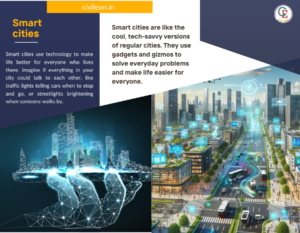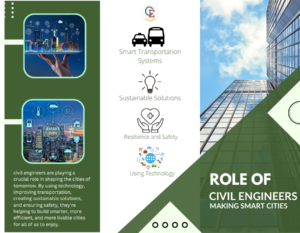In today’s world, cities are growing bigger and more complex. They’re becoming smarter, too, thanks to the work of civil engineers. Let’s explore how civil engineers are playing a crucial role in shaping the smart cities of tomorrow, making them smarter, greener, and more connected than ever before. Picture the city of your dreams – where traffic flows seamlessly, buildings sparkle with energy efficiency, and safety is paramount. That’s the vision of smart cities, and civil engineers are the architects behind this transformative journey.
In these evolving urban landscapes, civil engineers are the visionary problem solvers, blending innovation with practicality to create environments that enhance our lives.
What are Smart Cities?
First things first, what are smart cities? Well, imagine cities where everything is connected and working together to make life easier for everyone. That’s the goal of smart cities. They use technology to improve things like transportation, energy use, and even public safety.
Smart cities use technology to make life better for everyone who lives there. Imagine if everything in your city could talk to each other, like traffic lights telling cars when to stop and go, or streetlights brightening when someone walks by. That’s what smart cities do—they connect things like transportation, energy, and even garbage collection to make everything run smoother and safer. So, instead of just being regular cities, smart cities are like superheroes, using technology to make our lives easier and our cities better places to live!
Smart cities are like the cool, tech-savvy versions of regular cities. They use gadgets and gizmos to solve everyday problems and make life easier for everyone. Here’s how they work:
Connected Everything: In a smart city, things like traffic lights, buses, and even trash cans are all connected to a giant network. This means they can talk to each other and share information. For example, traffic lights can adjust based on how many cars are on the road, helping to reduce congestion.
Super Smart Transportation: Getting around in a smart city is a breeze. They have things like apps that tell you the best way to get from A to B, whether it’s by bus, bike, or foot. Some smart cities even have self-driving cars and buses that can pick you up and drop you off without a driver!
Energy Efficiency: Smart cities are all about saving energy. They use things like solar panels to generate electricity and smart meters to track how much energy people are using. This helps reduce waste and keeps the city running smoothly.
Green Spaces: Even in a big city, it’s important to have green spaces where people can relax and enjoy nature. Smart cities have parks and gardens filled with plants that help clean the air and cool down the city on hot days.
Safety First: Smart cities take safety seriously. They use cameras and sensors to monitor things like traffic and crime, making the city a safer place for everyone.
Overall, smart cities are like the high-tech superheroes of the urban world. They use technology to make cities cleaner, safer, and more enjoyable for everyone who lives there.
Role Of Civil Engineers
Civil engineers play a crucial role in making smart cities a reality. Civil engineers are instrumental in shaping smart cities by integrating technology, sustainability, and resilience into the urban fabric. Their expertise ensures that smart cities are not only efficient and livable but also resilient and safe for generations to come. Here’s how they contribute:
Designing Infrastructure: Civil engineers design the roads, bridges, tunnels, and buildings that form the backbone of a city. In smart cities, they incorporate features like sensors and data networks into these structures to make them more efficient and responsive to the needs of residents.
Smart Transportation Systems: Transportation is a big part of any city, and civil engineers are working hard to make it better. Civil engineers are responsible for designing transportation systems that keep people and goods moving smoothly throughout the city. This includes everything from designing bike lanes and pedestrian walkways to planning for high-speed trains and autonomous vehicles. They’re also working on projects like self-driving cars and high-speed trains to make getting around easier and faster.
Sustainable Solutions: Civil engineers are at the forefront of sustainability efforts in smart cities. They design buildings and infrastructure with energy-efficient materials and renewable energy sources like solar panels. They also implement green technologies for water management, waste disposal, and urban agriculture to minimize environmental impact.
Integrated Water Management: Civil engineers design and manage water systems to ensure a reliable supply of clean water for drinking, sanitation, and irrigation. In smart cities, they use advanced technologies like smart meters and sensors to monitor water usage and detect leaks, helping to conserve water resources and prevent pollution.
Resilience and Safety: Last but not least, civil engineers are also responsible for making sure that smart cities are safe for everyone. Civil engineers design infrastructure to withstand natural disasters such as earthquakes, floods, and hurricanes. In smart cities, they use advanced modeling and simulation techniques to assess risks and develop strategies for disaster preparedness and response. They also implement security measures to protect critical infrastructure from cyber threats and other security risks.
Using Technology: One of the key ways civil engineers are shaping smart cities is by using technology. They’re incorporating things like sensors and data analysis into their designs to make cities more efficient and sustainable. For example, sensors on roads can help manage traffic flow, reducing congestion and pollution.
In conclusion, civil engineers are playing a crucial role in shaping the cities of tomorrow. By using technology, improving transportation, creating sustainable solutions, and ensuring safety, they’re helping to build smarter, more efficient, and more livable cities for all of us to enjoy.
Smart Cities
Several cities around the world are considered leaders in the development and implementation of smart city initiatives. Here are a few examples:
Singapore: Often cited as one of the top smart cities globally, Singapore has implemented various initiatives to enhance urban living. These include smart transportation systems, such as congestion pricing and autonomous vehicles, as well as smart infrastructure for water management and energy efficiency.
Seoul, South Korea: Seoul has invested heavily in technology and innovation to become a leading smart city. It boasts initiatives like free public Wi-Fi, smart traffic management systems, and digital governance services for residents.
Barcelona, Spain: Barcelona is renowned for its efforts in utilizing technology to improve urban life. The city has implemented smart solutions in areas such as public transportation, waste management, and sustainability, earning it recognition as one of Europe’s leading smart cities.
Amsterdam, Netherlands: Amsterdam has embraced smart city concepts to enhance sustainability and quality of life for residents. Initiatives include smart mobility solutions like bike-sharing programs and electric vehicle infrastructure, as well as smart energy grids and innovative urban planning.
Tokyo, Japan: Tokyo is known for its advanced technology and efficient urban infrastructure. The city has implemented smart transportation systems, disaster preparedness measures, and digital governance platforms to improve the quality of life for its residents.
Dubai, United Arab Emirates: Dubai has made significant investments in becoming a smart city of the future. It has implemented initiatives such as smart government services, blockchain technology for secure transactions, and ambitious plans for sustainable urban development.
Feel free to follow us there on Instagram and drop a comment to say hello!


